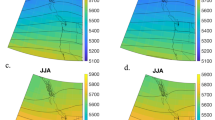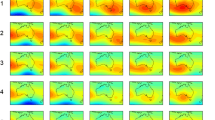Abstract
The evolution of daily synoptic weather patterns is the main driver of day-to-day weather change. These patterns are generally associated with changes in temperature, precipitation, etc., especially during extreme weathers. Evaluating the ability of climate models to reproduce the frequency and intensity of daily synoptic patterns is essential for increasing confidence in future projections. In this study, we investigated the ability of 34 global climate models (GCMs) included in the Coupled Model Intercomparison Project Phase 5 (CMIP5) to simulate synoptic patterns over East Asia and their evolution features in winter and summer. Daily synoptic patterns in sea level pressure and their occurrence frequencies were identified by using an objective clustering algorithm, self-organizing maps (SOMs). The evaluation consists of correlating the frequencies of these patterns in the 34 CMIP5 models with the frequencies in the NCEP reanalysis during the baseline period of 1980–1999. The results illustrated that most of these models were able to reproduce the synoptic patterns of the NCEP reanalysis. In addition, the frequencies of temporal sea level pressure (SLP) anomaly patterns were reproduced by most of the models over the baseline period, but the frequencies of spatial SLP anomaly patterns were only reproduced by a few GCMs. Overall, the models performed better in summer than in winter. Comprehensive evaluation shows that the four top-performing models for both winter and summer are bcc-csm1-1-m, NorESM1-M, MRI-CGCM3, and CCSM4. They show good performance in simulating the daily synoptic patterns in SLP and in reproducing their occurrence frequencies. The results showed that the SOM was an effective tool for differentiating characteristics of synoptic circulation patterns and for evaluating the ability of climate models to simulate the frequency of daily synoptic patterns. The results can also help users to choose a better model for future climate projection and downscaling over East Asia.
Similar content being viewed by others
References
Bao Yan, Gao Yanhong, Lü Shihua, et al., 2014: Evaluation of CMIP5 earth system models in reproducing leaf area index and vegetation cover over the Tibetan Plateau. J. Meteor. Res., 28, 1041–1060, doi: 10.1007/s13351-014-4032-4.
Cavazos, T., 2000: Using self-organizing maps to investigate extreme climate events: An application to wintertime precipitation in the Balkans. J. Climate, 13, 1718–1732.
Chen, H. P., 2013: Projected change in extreme rainfall events in China by the end of the 21st century using CMIP5 models. Chin. Sci. Bull., 58, 1462–1472.
Chu, J. E., S. N. Hameed, and K. J. Ha, 2012: Nonlinear, intraseasonal phases of the East Asian summer monsoon: Extraction and analysis using self-organizing maps. J. Climate, 25, 6975–6988.
Cohen, L., S. Dean, and J. Renwick, 2013: Synoptic weather types for the Ross sea region, Antarctica. J. Climate, 26, 636–649.
Dayan, U., A. Tubi, and I. Levy, 2012: On the importance of synoptic classification methods with respect to environmental phenomena. Int. J. Climatol., 32, 681–694.
Finnis, J., J. Cassano, M. Holland, et al., 2009: Synoptically forced hydroclimatology of major Arctic watersheds in general circulation models. Part 1: The Mackenzie River basin. Int. J. Climatol., 29, 1226–1243.
Guo Yan, Chen Haishan, Zhang Hongfang, et al., 2012: Assessment of CMIP3 climate models performance in simulation of winter atmospheric general circulation over East Asia. Meteorology and Disaster Reduction Research, 35, 7–16. (in Chinese)
He, C., and T. J. Zhou, 2014: The two interannual variability modes of the western North Pacific subtropical high simulated by 28 CMIP5-AMIP models. Climate Dyn., 43, 2455–2469.
He, C., and T. J. Zhou, 2015: Responses of the western North Pacific subtropical high to global warming under RCP4.5 and RCP8.5 scenarios projected by 33 CMIP5 models: The dominance of tropical Indian Ocean-tropical western Pacific SST gradient. J. Climate, 28, 365–380.
Hewitson, B. C., and R. G. Crane, 2002: Self-organizing maps: Applications to synoptic climatology. Climate Res., 22, 13–26.
Jiang Dabang and Tian Zhiping, 2013: East Asian monsoon change for the 21st century: Results of CMIP3 and CMIP5 models. Chin. Sci. Bull., 58, 1427–1435.
Kalnay, E., M. Kanamitsu, R. Kistler, et al., 1996: The NCEP/NCAR 40-year reanalysis project. Bull. Amer. Meteor. Soc., 77, 437–471.
Kohonen, T., 1982: Self-organized formation of topologically correct feature maps. Biological Cybernetics, 43, 59–69.
Kohonen, T., 2001: Self-Organizing Maps. 3rd ed. Springer-Verlag, New York, 501 pp.
Li, H. M., L. Feng, and T. J. Zhou, 2011: Multi-model projection of July–August climate extreme changes over China under CO2 doubling. Part I: Precipitation. Adv. Atmos. Sci., 28, 433–447.
Li, H. M., L. Feng, and T. J. Zhou, 2011: Multi-model projection of July–August climate extreme changes over China under CO2 doubling. Part II: Temperature. Adv. Atmos. Sci., 28, 448–463.
Li Ruiqing, Lü Shihua, Han Bo, et al., 2015: Connections between the South Asian summer monsoon and the tropical sea surface temperature in CMIP5. J. Meteor. Res., 29, 106–118, doi: 10.1007/s13351-014-4031-5.
Liu, Y. G., and R. H. Weisberg, 2005: Patterns of ocean current variability on the West Florida Shelf using the self-organizing map. J. Geophys. Res., 110, C06003, doi: 10.1029/2004JC002786.
Liu, Y. G., R. H. Weisberg, and R. Y. He, 2006: Sea surface temperature patterns on the West Florida Shelf using growing hierarchical self-organizing maps. J. Atmos. Oceanic Technol., 23, 325–338.
Liu, Y., R. H. Weisberg, and C. N. K. Mooers, 2006: Performance evaluation of the self-organizing map for feature extraction. J. Geophys. Res., 111, C05018, doi: 10.1029/2005JC003117.
Liu Min and Jiang Zhihong, 2009: Simulation ability evaluation of surface temperature and precipitation by thirteen IPCC AR4 coupled climate models in China during 1961–2000. J. Nanjing Inst. Meteor., 32, 256–268. (in Chinese)
Liu Yunyun, Li Weijing, Zuo Jinqing, et al., 2014: Simulation and projection of the western Pacific subtropical high in CMIP5 models. J. Meteor. Res., 28, 327–340.
Ning, L., M. E. Mann, R. Crane, et al., 2012: Probabilistic projections of climate change for the Mid-Atlantic region of the United States: Validation of precipitation downscaling during the historical Era. J. Climate, 25, 509–526.
Paraschivescu, M., N. Rambu, and S. Stefan, 2012: Atmospheric circulations associated to the interannual variability of cumulonimbus cloud frequency in the southern part of Romania. Int. J. Climatol., 32, 920–928.
Radć, V., and G. K. C. Clarke, 2011: Evaluation of IPCC models’ performance in simulating late-twentiethcentury climatologies and weather patterns over North America. J. Climate, 24, 5257–5274.
Raziei, T., A. Mofidi, J. A. Santos, et al., 2012: Spatial patterns and regimes of daily precipitation in Iran in relation to large-scale atmospheric circulation. Int. J. Climatol., 32, 1226–1237.
Reusch, D. B., R. B. Alley, and B. C. Hewitson, 2005: Relative performance of self-organizing maps and principal component analysis in pattern extraction from synthetic climatological data. Polar Geography, 29, 188–212.
Reusch, D. B., R. B. Alley, and B. C. Hewitson 2007: North Atlantic climate variability from a selforganizing map perspective. J. Geophys. Res., 112, D02104, doi: 10.1029/2006JD007460.
Schuenemann, K. C., and J. J. Cassano, 2009: Changes in synoptic weather patterns and Greenland precipitation in the 20th and 21st centuries. 1: Evaluation of late 20th century simulations from IPCC models. J. Geophys. Res., 114, doi: 10.1029/2009JD011705.
Song, F. F., and T. J. Zhou, 2014: Interannual variability of East Asian summer monsoon simulated by CMIP3 and CMIP5 AGCMs: Skill dependence on Indian Ocean–western Pacific anticyclone teleconnection. J. Climate, 27, 1679–1697.
Song, F. F., and T. J. Zhou, 2014: The climatology and interannual variability of East Asian summer monsoon in CMIP5 coupled models: Does air-sea coupling improve the simulations? J. Climate, 27, 8761–8777.
Song, F. F., T. J. Zhou, and Y. Qian, 2014: Responses of East Asian summer monsoon to natural and anthropogenic forcings in the 17 latest CMIP5 models. Geophys. Res. Lett., 41, 596–603.
Sperber, K. R., H. Annamalai, I. S. Kang, et al., 2013: The Asian summer monsoon: An intercomparison of CMIP5 vs. CMIP3 simulations of the late 20th century. Climate Dyn., 41, 2711–2744.
Taylor, K. E., R. J. Stouffer, and G. A. Meehl, 2012: An overview of CMIP5 and the experiment design. Bull. Amer. Meteor. Soc., 93, 485–498.
Xu, C. H., and Y. Xu, 2012: The projection of temperature and precipitation over China under RCP scenarios using a CMIP5 multi-model ensemble. Atmos. Oceanic Sci. Lett., 5, 527–533.
Xu, Y., and C. H. Xu, 2012: Preliminary assessment of simulations of climate changes over China by CMIP5 multi-models. Atmos. Oceanic Sci. Lett., 5, 489–494.
Zhang Hongfang and Chen Haishan, 2011: Evaluation of summer circulation simulation over East Asia by 21 climate models. Part I: Climatology. Scientia Meteor. Sinica, 31, 119–128. (in Chinese)
Zhang Ying, 2012: Projections of 2.0? warming over the globe and China under RCP4.5. Atmos. Oceanic Sci. Lett., 5, 514–520. (in Chinese)
Zhao, Z. C., Y. Luo, and J. B. Huang, 2013: A review on evaluation methods of climate modeling. Adv. Climate Change Res., 4, 137–144.
Zhou, T. J., and R. C. Yu, 2006: Twentieth-century surface air temperature over China and the globe simulated by coupled climate models. J. Climate, 19, 5843–5858.
Zhou, T. J., B. Wu, and B. Wang, 2009: How well do atmospheric general circulation models capture the leading modes of the interannual variability of the Asian-Australian monsoon? J. Climate, 22, 1159–1173.
Zhou, T. J., and L. W. Zou, 2010: Understanding the predictability of East Asian summer monsoon from the reproduction of land-sea thermal contrast change in AMIP-type simulation. J. Climate, 23, 6009–6026.
Zhou, T. J., and J. Zhang, 2011: The vertical structures of atmospheric temperature anomalies associated with two flavors of El Ni˜no simulated by AMIP II models. J. Climate, 24, 1053–1070.
Zhou Tianjun, Chen Xiaolong, Dong Lu, et al., 2014: Chinese contribution to CMIP5: An overview of five Chinese models’ performances. J. Meteor. Res., 28, 481–509, doi: 10.1007/s13351-014-4001-y.
Author information
Authors and Affiliations
Corresponding author
Additional information
Supported by the National Natural Science Foundation of China (41230528 and 41205162), National (Key) Basic Research and Development (973) Program of China (2012CB955204), and Priority Academic Program Development of Jiangsu Higher Education Institutions.
Rights and permissions
About this article
Cite this article
Wang, Y., Jiang, Z. & Chen, W. Performance of CMIP5 models in the simulation of climate characteristics of synoptic patterns over East Asia. J Meteorol Res 29, 594–607 (2015). https://doi.org/10.1007/s13351-015-4129-4
Received:
Accepted:
Published:
Issue Date:
DOI: https://doi.org/10.1007/s13351-015-4129-4




